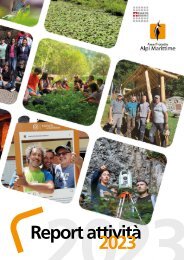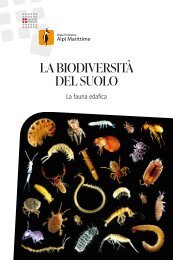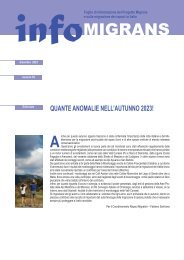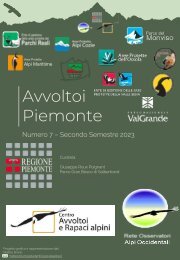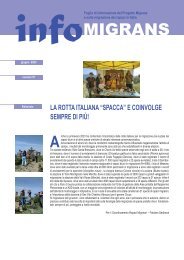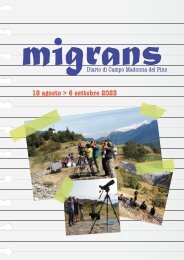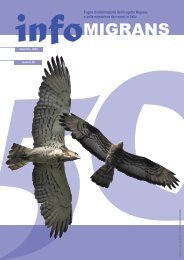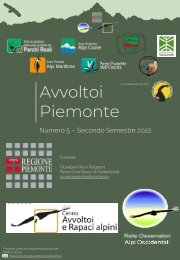infoGIPETO n.35 | dicembre 2018
Periodico d'informazione sul progetto di reintroduzione del gipeto.
Periodico d'informazione sul progetto di reintroduzione del gipeto.
You also want an ePaper? Increase the reach of your titles
YUMPU automatically turns print PDFs into web optimized ePapers that Google loves.
IL GIPETO IN ANDALUSIA,<br />
UNA VITTORIA CONTRO IL VELENO<br />
CONSERVAZIONE & MEETING ANNUALE<br />
CONSERVATION & ANNUAL MEETING<br />
Enrique Avila, Raphael Arenas & Francisco Rodriguez Peinado<br />
Agencia de Medio Ambiente y Agua.<br />
Consejería de Medio Ambiente y Ordenación del Territorio - Junta de Andalucia<br />
BEARDED VULTURE IN ANDALUSIA, A VICTORY AGAINST POISON<br />
In Andalusia, the last bird disappeared in 1986. After that, the Iberian bearded vultures were relegated to the Pyrenees. The main cause of disappearance<br />
was the widespread use of poisoned baits and the pillaging of nests.<br />
Currently, the main conservation problem is the lack of connection between the different existing populations. A viable population in southern<br />
Spain, would allow to restore the genetic flow between the Pyrenees and North Africa, thus contributing to the global conservation of the species.<br />
The first release of individuals was carried out in 2006. The feasibility of the project was threatened by the death of several poisoned birds, leading<br />
to suspension of the releases in 2011. The great work in contrast of poison allowed to overcome this adversity and now the population is growing.<br />
The first pair successfully raised a juvenile in 2015, despite the female was just 5 years old. A second pair formed in 2017 and until now 5 juveniles<br />
fledged. Currently (end of <strong>2018</strong>), 4 pairs established.<br />
In Andalusia il gipeto è scomparso alla fine del 1986, a causa dell’esteso uso di esche avvelenate e<br />
il furto di pulcini. La popolazione in Spagna era quindi relegata ai Pirenei. Ricreare una popolazione<br />
vitale nel sud della Spagna è fondamentale per ristabilire il flusso genetico tra i Pirenei e il Nord Africa.<br />
In Andalusia i primi gipeti furono reintrodotti nel 2006; i rilasci furono sospesi temporaneamente nel<br />
2011 a causa della morte per avvelenamento di diversi individui. Il grande lavoro di contrasto all’uso<br />
del veleno tramite l’utilizzo di squadre cinofile addestrate (Figura 1), ha decisamente ridotto questa<br />
minaccia. La prima nidificazione di successo è avvenuta nel 2015, da parte di una femmina di soli 5<br />
anni di età. Finora, si sono involati 5 giovani ma questo numero è destinato a crescere velocemente<br />
poiché, nel <strong>2018</strong> si sono già insediate 4 coppie.<br />
Risultati del Simposio internazionale sul gipeto a Cazorla<br />
José Tavares – Vulture Conservation Foundation<br />
Results of the Annual meeting in Cazorla Andalusia has great merits: raising awareness in hunters<br />
in order to contrast lead ammunition, successful fight against illegal poisoning and the excellent results<br />
of the Centro de Cria de Guadalentin, one of the most productive within the captive breeding network<br />
Also, thanks to these brilliant results, Junta de Andalusia will join IBM network as new partner and this<br />
year hosted the annual meeting with the participation of more than 150 people from 14 countries (Morocco,<br />
Portugal, Spain, Andorra, France, UK, Belgium, Germany, Switzerland, Austria, Italy, Bulgaria,<br />
Macedonia & Romania).<br />
The discussed topics ranged from the species conservation and monitoring across Europe, Morocco<br />
and Ethiopia to scientific research on lead poisoning of hunting origin and mortality causes. In 2019<br />
the VCF is going to release birds in France, Andalusia and individuals of rare genetic lineages in the<br />
Alps in order to boost the low genetic diversity.<br />
The “Bearded Vultures on the Move” crowdfunding campaign was successful, allowing to transfer 19<br />
birds across the captive breeding network to keep them safe from disease and improve the breeding<br />
success.<br />
Più di 150 persone provenienti da 14 Paesi (Marocco, Portogallo, Spagna, Andorra, Francia, Regno<br />
Unito, Belgio, Germania, Svizzera, Austria, Italia, Bulgaria, Macedonia e Romania) si sono riuniti, nel<br />
novembre <strong>2018</strong>, a Cazorla (Andalusia),per il Simposio Annuale sul Gipeto.<br />
L’Andalusia entrerà a far parte di IBM per numerosi meriti: importanti risultati, che hanno consentito<br />
l’insediamento di una nuova popolazione riproduttiva dopo l’estinzione, sono stati ottenuti nella lotta<br />
contro il veleno e nella sensibilizzazione dei cacciatori per utilizzare munizionamenti alternativi al<br />
piombo.<br />
Inoltre, ingenti risorse sono state investite nel Centro di allevamento di Guadalentin, che è diventato<br />
un modello di eccellenza nel programma di allevamento del gipeto in cattività.<br />
I lavori presentati al meeting hanno trattato la conservazione, il monitoraggio della specie in Europa,<br />
Marocco ed Etiopia nonché alcune ricerche sull’intossicazione da piombo di origine venatoria nei<br />
grandi rapaci.<br />
Nel 2019, la VCF continuerà a rilasciare<br />
giovani gipeti in Francia nell’ambito del<br />
Progetto Life GypHelp e in Andalusia,<br />
mentre sulle Alpi saranno ancora liberati<br />
individui appartenenti a rare linee genetiche<br />
con lo scopo di aumentare la bassa<br />
diversità genetica. Tramite una raccolta<br />
fondi particolarmente riuscita, sono stati<br />
redistribuiti 19 individui tra i diversi Centri<br />
di allevamento, allo scopo di prevenire<br />
l’insorgere di malattie e creare nuove<br />
coppie.<br />
Figura 1 - Uno dei momenti più entusiasmanti<br />
del recente Simposio internazionale di Cazorla:<br />
l’esercitazione pratica dei cani antiveleno<br />
impiegati con successo in Andalusia. One of<br />
the most exciting events occurred during the<br />
annual bearded vulture meeting of Cazorla.<br />
Anti-poisoning dog units have been successfully<br />
employed in Andalusia in order to contrast<br />
the main threat. Foto: Alberto Pastorino<br />
31




